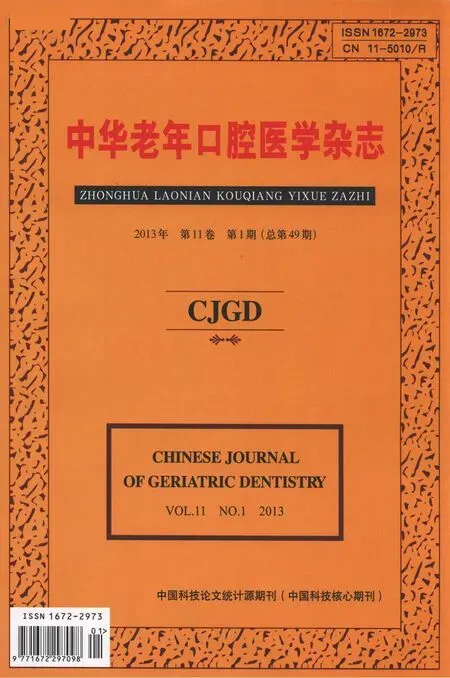牙周炎与冠心病相关性的研究进展*
王丽娟 缪 羽 赵 峰
慢性牙周炎(chronic periodontitis)是由牙菌斑中的微生物引起的牙周支持组织的慢性感染性疾病,表现为炎症、牙周袋形成、进行性附着丧失和牙糟骨吸收,最后可导致牙松动和脱落,它是我国成年人丧失牙齿的首位原因[1]。
冠状动脉粥样硬化性心脏病(coronary heart disease CHD)简称冠心病,主要因冠状动脉粥样硬化使血管腔狭窄或阻塞,导致心肌缺血、缺氧而引起的心脏病[2]。
冠心病是目前主要的致死性疾病之一,尽管吸烟、肥胖、高血压都是公认的致病危险因素,但它们所引起的冠心病仅占临床冠心病总发病率的50%- 70%,研究显示,感染因子是动脉粥样硬化形成的危险因素之一。牙周炎感染与CHD 存在内在联系,两种疾病有共同的临床危险因素,如吸烟、高龄、糖尿病、精神压力等,感染正成为冠心病发病因素的研究热点之一[3]。
1. 牙周炎与冠心病相关性的流行病学研究
研究人员发现,牙周炎增加了人们患心脏病和脑卒中的风险[4]。在冠心病危险因素分析中,排除冠心病易患因素吸烟、年龄、性别、肥胖、甘油三酯、总胆固醇、糖尿病、高血压、高密度脂蛋白胆固醇及低密度脂蛋白胆固醇后,发现慢性牙周炎仍是预测冠心病发生的独立因素[5]。Beck 等[6]在研究中发现,牙周袋深度、牙槽骨丧失量与冠心病和脑出血密切相关。与健康人群相比较,重度牙周炎男性患者患冠心病的概率增加3 倍。Gotsman 等对冠心病就诊患者进行横断面调查经Logistic 回归分析发现患者菌斑指数、牙龈指数牙龈卟啉单胞菌检出率与急性冠脉综合症显著相关,与症状严重程度一致[7]。张源明等调查分析发现慢性牙周炎和冠心病存在剂量反应关系,随着慢性牙周炎程度的加重,患冠心病的危险度(OR)递增,且该剂量反应关系有统计学意义。德国ULM 大学医疗中心的学者认为任何来源的慢性炎症均与心血管风险增加有关。多变量分析结果显示牙周病原体负荷(所有病原体总数的log10)与CHD 发生显著相关(几率1.92,P<0.001)[8]。
2. 牙周致病菌与冠心病的关系
牙周病是以细菌为主的多因素疾病,牙菌斑中牙龈卟啉单胞菌(Pg)、伴放线放线杆菌(Aa)、齿垢密螺旋菌(Td)等均为公认牙周炎致病菌[9]。随着研究深入,Padilla 等[10]在冠状动脉粥样硬化斑块中发现了牙周病相关致病菌的存在,这表明牙周病和冠心病在细菌层面存在相关性。Pg 与内皮细胞相互作用,诱导平滑肌细胞增生,内皮细胞损伤,血管壁增厚,并能躲避溶菌酶的作用存活于内皮细胞,可加速动脉粥样硬化斑块的免疫反应,从而影响病变的发展。Koizum i 等[11]发现,导致牙周慢性炎症的Pg 可加速动物模型中动脉粥样硬化斑块的堆积。研究显示[12],Pg 可引发或加速动脉粥样硬化的发展,血链球菌和牙龈卟啉单胞菌可促进血小板聚集,加速血凝,形成血栓,加速冠心病的发生。Nakano 等[13]研究了牙周病细菌和动脉粥样斑块及心脏瓣膜中的细菌,结果在10.4%的心血管样品中检出牙龈卟啉单胞菌。Sakurai 等[14]研究了151 例冠脉综合征(acute coronary synd rome ACS)患者发现Aa 存在于1/ 3ACS 患者的唾液和龈下菌斑中。Sazuyuki 等[15]用PCR 法检测51 位成人冠心病病人冠状动脉狭窄斑块样本,其中Pg、Aa、Td 检出率分别为21.6%,23.3%,23.5%。Haraszthy等[16]以16SrDNA 方法检测50 例动脉粥样硬化斑块中的主要致病菌,发现Pg 的阳性率为26%,Aa 的阳性率为18%。
牙周炎致病菌可导致牙周局部组织炎症,牙龈溃疡和血管改变及细胞的转运,血管内皮功能障碍,从而增加动脉粥样斑块形成的可能性。
3. 与牙周炎密切相关的炎性因子与冠心病的关系
大量的实验室检查提示心梗的危险因素与牙周炎症时的系统标志物相一致,前者增高时,其牙周炎患者的系统炎症标志物明显提高。如超敏C反应蛋白(high- sensitivity C- reactive protein,hs- CRP)、纤维蛋白原(Fibrinogen Fg)、白细胞介素- 6(Interleukin- 6 IL- 6)、血脂等均有提高[17]。牙周病越严重,全身炎症反应越明显[18]。
3.1 hs- CRP hs- CRP 是一种仅在感染或非感染来源的炎症性疾病的急性期出现的蛋白,为有力的危险标志。hs- CRP 通过促进白细胞活化,改变内皮细胞功能直接参与病损形成,表现为上调粘附因子和趋化因子,促进内皮细胞凋亡和抑制血管生成等。美国心脏病协会及疾病控制及预防中心建议将hs- CRP作为评估心血管疾病严重性的临床检测指标[19]。一般用于心血管疾病危险性评估时,hs- CRP 大于等于3.0mg/ L 者被认为具有高度危险性。Salzberg 等[20]检测了侵袭性牙周炎患者及牙周健康者的血清hs- CRP 质量浓度;结果发现,广泛型侵袭性牙周炎患者的血清hs- CRP 比健康者高,牙周治疗可降低hs- CRP 质量浓度。Tonetti等[21]发现,重度牙周炎患者经拔牙、根面平整、刮治等牙周系统治疗后的第一天,血液中的hs- CRP细胞因子显著升高,治疗后6 个月这些细胞因子又显著下降,内皮细胞功能改善,表明牙周治疗可改善心血管功能。
3.2 纤维蛋白原(Fibrinogen Fg) 纤维蛋白原(Fibrinogen Fg)是由肝脏合成的一种Ⅱ类急性相血浆糖蛋白,其浓度正常范围为2- 4g/ L,在机体受损伤或炎症时,浓度成倍增高。临床研究发现Fg 水平的升高是冠心病的独立危险因素,认为Fg增高可导致血液粘稠度升高同时增加脂质聚集,Fg与CHD 的发生发展也密切相关[22]。牙周病是一种微生物感染引起的炎症性疾病,其炎症刺激可导致机体发生急性期反应,使血液循环中急性期蛋白升高,Fg 就是其中一种。牙周感染和炎症状态可使Fg 水平升高,而Fg 的过量产生又影响炎症反应和CHD 等心血管疾病的发生发展并参与牙周炎的发病机制。因此,Fg 可能成为联系牙周炎和CHD的桥梁分子[23]。实验室结果显示:牙周炎病人的系统炎症标志物Fg 明显升高[24],Fg 是在感染性疾病或者组织损伤的急性期出现的蛋白,炎症下急剧升高,研究证实Fg 是心血管疾病重要的、独立的危险因素[25]。
3.3 白细胞介素- 6(Interleuk in- 6 IL- 6) IL- 6是由多种淋巴细胞和非淋巴细胞自发地或在各种刺激下产生的细胞因子。IL- 6 可加重牙周炎症反应,减弱牙周组织的修复能力,破坏牙槽骨。IL- 6 是被誉为白细胞介素的家族“核心成员”的细胞因子,其与冠心病发病有密切关系。D’A iuto 等[26]发现,牙周炎患者在行刮治和根面平整术后,其血清炎症因子IL- 6 显著下降。Danesh 等[27]的研究表明,随着IL- 6 水平的逐步增高,发生CHD 的危险也在增加。国外报道[28],IL- 6 在不稳定心绞痛水平明显增高,其可作为判断病情严重程度的指标。有研究认为CHD 患者牙周治疗后,血清的IL- 6 有所降低[29]。
3.4 血脂 脂类在动脉粥样硬化中起了一定的作用。牙周感染后,牙周细菌的成份脂多糖(lipoplysac charide,LPS)促进巨噬细胞活化。LPS、巨噬细胞和炎症介质形成的复合物,可以再促进细胞因子释放,内皮单核细胞的黏附,导致动脉粥样硬化的发生。在国内,王岩等[30]的横断面调查研究认为,总胆固醇、甘油三酯均与牙周炎的患病率相关。关于牙周治疗对血脂影响的研究,D’A iuto等[31]的研究结果显示,牙周基础治疗后3 个月,单纯慢性牙周炎患者血清中总胆固醇的水平显著降低。土耳其的学者O2等[32]对50 例当地就诊的慢性牙周炎伴高血脂患者进行牙周治疗,3 个月后总胆固醇和低密度脂蛋白水平显著下降(P<0.05),甘油三酯和高密度脂蛋白水平的变化差异无统计学意义(P>0.05)。
综上所述,牙周治疗对CHD 影响的研究还处于初步阶段,大多数研究表明,牙周治疗可在一定程度上降低患者血清中炎症因子的水平,改善血管功能,有利于降低CHD 的危险。我们应该给予牙周组织的健康以更多的关注,并预防牙周病的发生,以改善全身状况。
[1] 孟换新. 牙周病学[M]. 3 版. 北京:人民卫生出版社,2008:156
[2] 陆再英,钟南山,谢 毅,等. 内科学[M]. 7 版. 北京:人民卫生出版社,2008:274
[3] K linger A,Goldstein M,Soskolne A,et al.Periodontal disease- an additional risk factor for cardiovasular disease[J].Refuat- Hapeh- Vehashinagim,2002,19:67- 74
[4] Schillinger T, K lnger W, Exner M, et al. Dental and periodontal status and risk for progression of carotid atherosclerosis.The inflammation and carotid artery risk for atherosclerosis study dental substudy [J]. Stroke,2006,37(9):2271- 2276
[5] 张源明,钟良军,何秉贤,等. 冠心病和慢性牙周炎相关性研究[J]. 中华流行病学杂志,2006,27(3):256- 259
[6] Beck JD, Eke P, Lin D, et al. Associations betw een IgG antibody to oral organism s and carotid intim a- medial th ickness in comm unity- dw elling adu lts[J]. A therosclerosis, 2005,183(2):342- 349
[7] Gotsman I, Lotan C, Soskolane A, et al. Periodontal destruction is associated with coronary arter disease periodontal in fection with acute coronary syndrom e[J]. J Periodontal,2007,78(5):849- 858
[8] Spah r A, K lein E, Khusey inova N, et al. Periodontal in fections and coronary heart disease: role of periodontal bacteria and importance of total pathogen burden in the Coronary Event and Periodontal Disease(CORODONT)study[J]. J Intern Med,2006,166(5):554- 559
[9] 曹采方. 牙周病学[M]. 北京:人民卫生出版社,2008:51- 19
[10] 孟培松,魏忠敏,白雪峰,等. 牙周病和冠心病相关性的初步讨论[J]. 牙体牙髓牙周病学杂志,2006,16(1):38- 40
[11] Koizum i Y, kurita- ochiai T, Oguchi S, et al. Intranasal immunization with Porphy romonas gingivalis and atherosclerosis[J]. Imm unopharmacal Imm unotoxicol,2009,31(3):352- 357
[12] Herzberg MC, Nobbs A, Tao L, et al. Oral strep tococci and cardiovascular disease: searching for the platelet aggregation- associated protein gene and m echanism s of Streptococcus sanguis- induced th rombosis[J]. J Periodontal,2005,76(11):2101- 2105
[13] Nakano K, Inaba H, Nomura R, et al. Distribution of Porphyomonas gingivalis fim A genotypes in cardiovascular specimens from Japanese patients [J]. Oral M icrobiol Immunol,2008,23(2):170- 172
[14] Sakurai K,W ang D, Sazuk i J, et al. H igh incidence of actinobacillus actinom ycetem com itans in fection in acute coronary syndrome[J]. Int Heart J,2007,48(6):663- 673
[15] Ishihara K, Nabuchi A, Ito R, et al. Correlation betw een detection rates of periodontopathic bacterial DNA in coronary stenotic artery plaque and in dental plaque sam ples. J Clin M icrobiol,2004,42(3):1313- 1315
[16] Haraszthy VI, Zambon JJ, Trevisan M, et al. Identification of periodontal pathogens in atherom atous plaques. J Periodontol,2000,71(10):1554- 1559
[17] Moutsopou ls NM, Madianos PN. Low- grade infection in ch ronic infections disease: paradigm of periodontal in fections[J]. Annals of the new York Academ y of Sciences,2006 Nov,1088:251- 264
[18] Jashipara KJ, W and HC, Merchant AT, et al. Periodontal disease and biomarkers related to cardiovascular disease[J].Dent Res,2004,83(2):151- 155
[19] Pearson TA, Mensah GA, A lexander RW, et al. Markers of inflamm ation and cardiovasclar disease: Application to clinical and public health practice:A statement for healthcare professionals from the Centers for Disease Control and Prevention and the American Heart Association[J]. Circulation,2003,107(3):499- 511
[20] Salzberg TN, Overstreet BT, Rogers JD, et al. C- reactive protein levels in patients with aggressive periodontitis[J]. J Periodontal,2006,77(6):933- 939
[21] Tonetti MS, D’Aiuto F, Nibali L. Treatment of periodontitis and endothelial function[J]. N Eng l J Med,2007,356(9):911- 920
[22] Vischetti M, Zito F, Donati MB, et al. Analysis of gene- environment interaction in coronary heart disease: fibrinogen polymorphisms as an exam ple[J]. Ital Heart J,2002,3(1):18- 31
[23] W u T, Trevisan M, Genco RJ, et al. Exam ination of the relation betw een periodontal health status and cardiovascular risk factors: serum total and high density lipoprotein cholesterol, C- reactive protein,and plasma fibrinogen[J]. Am J Epidem iol,2000Feb,151(3):273- 282
[24] ParaskevasS, Huizinga JD, Loos BG, et al. A system atic review and meta analyses on c- reactive protein in relation to periodontitis[J]. J Clin Periodontal,2008,35(4):277- 290
[25] Tekio Pocan B, Borazan A, et al. Positive correlation of CRP and fibrinogen levels as cardiovascu lar risk factors in early stage of continous am bu latory peritoneal dialysis patients[J].Ren Fail,2008,30(2):219- 225
[26] D’A iuto F, Ready D, Tonetti MS.Periodontal disease and C- reactive protein- associated cardiovascular riek[J]. J Periodontal Res,2004,39(4):236- 241
[27] Danesh J, Kaptoge S, Mann AG, et al. Long- term interleukin- 6 levels and subsequent risk of coronary heart disease:tw o new p rospective studies and a system atic review[J]. PLos Med,2008,5(4):78
[28] Rid kRifai N, Stam pfer MJ, et al. Plasma concentration of interleuk in- 6 and the risk of future m yocardial in farction am ong apparently healthy m en[J]. Circulation,2000,101(15):1767- 72
[29] Tay lor B, Tofler G, Morel- Kopp MC, et al. The effect of initial treatment of periodontitis on system ic markers of inflammation and cardiovascular risk: a random ized controlled trial[J]. Eur J Oral Sci,2010,118(4):350- 356
[30] 王 岩,吴忠荣,尚姝环,等. 武汉市公务员血脂水平与牙周炎相互性的调查[J]. 牙体牙髓病学杂志,2007,17(1):33-36
[31] D’A iuto F, Parkar M, NibaliL, et al. Short- term effects of intensive periodontal therapy on serum in flamm atory markers and chelestero[J]. JD ent Res,2005,84(3):1129-1135
[32] O2SG, Fentog lu O, k ilicarslan A, et al. Beneficial effects of periodontal treat ent on m etabolic: control of hypercholesterolem ia[J]. South Med J,2007,100(7):686- 671

